
Things were looking up for Richard Romero, founder of Seichou Karate in Alexandria. The Old Town dojo is facing imminent closure thanks to redevelopment, but Romero finally found a new home just northeast of Springfield.
But, like a crane kick at the end of a karate championship, Romero said some surprising zoning issues have cropped up that could spell trouble for plans to open Seichou Karate at 5710 General Washington Drive.
“We found a place on General Washington Drive in Fairfax,” Romero said. “It’s in a warehouse-type structure. The space is just off I-395. It’ll be a good new home for us but we’ve encountered some difficulties.”
After 18 years in Old Town, Romero struggled to find a new space to fit the needs of the dojo. Romero said larger businesses like Amazon have been buying up warehouses and flex space in the area and, after 18 months of searching, he found a suitable location in Springfield.
Romero admitted he was so excited by the new location and worried he’d lose it that he didn’t do a feasibility study.
“I didn’t do a feasibility study and that was a mistake,” Romero said. “I had no idea we would run into so many bureaucratic complications.”
The main issue, Romero said, has been parking. Romero said the school will have 20 students and two staff and Fairfax County has told him that it means he needs 22 parking spaces, which is unlikely for the shopping center-like space.
“That’s where we’re really hung up right now,” Romero said. “They say I need 22 parking spaces, 24/7. But that doesn’t reflect how our business works.”
Romero said his classes get started around 4:30/5 p.m., which is when many of the nearby light industrial and supply businesses close.
“There’s plenty of parking if you go there any time of the day,” Romero said, “but the county says this space — with maybe 20 tenants in the whole building –simply doesn’t have enough parking spaces to include all the tenants.”
A Fairfax County spokesperson said because Seichou Karate is a new use for the site, it has different parking requirements than the previous tenant.
“When a new tenant has different parking requirements than the previous tenant, it requires a more in-depth review of the application by the county,” the spokesperson said. “The previous use was an establishment for production that only required four spaces. Seichou Karate is a school of specialized instruction that requires several more parking spaces to accommodate staff and students.”
The spokesperson said in these cases, the applicant must submit a parking tabulation to demonstrate the site can accommodate the parking required for this use, which the spokesperson said Seichou Karate has not.
“I’ve tried to reason with them,” Romero said. “I’ve said ‘please, look at the parking lot during the daytime’ but they say no, the rules are the rules.”
Romero said that parking tabulation required by the County is costly, around $5,500, with a $1,000 filing fee.
“To boot, since July, I’ve been paying two landlords,” Romero said. “We’re not causing congestion and there’s plenty of space… They’re not willing to apply those rules in a way that makes sense.”
Romero said he has to be out of his current space in Alexandria by Dec. 31 and it’s looking unlikely that Seichou Karate will be open in Fairfax by that time.
“Getting that ready by December, even if it were approved now, is fanciful at best,” Romero said. “It’s really a kafkaesque nightmare.”
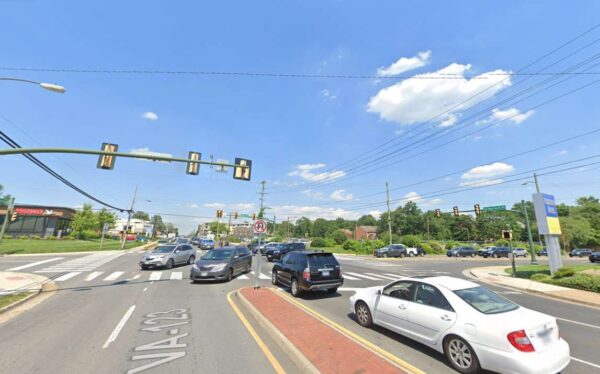
At a Vienna Town Council meeting this week it was revealed that, with any luck, work could start on overhauling one of the town’s most dangerous intersections before the year’s end.
The Vienna Town Council voted unanimously on Monday, Aug. 28, to approve construction services and management for improvements to the intersection of Maple Avenue and Nutley Street.
The Nutley Street intersection was one of three along Maple Avenue identified as a crash hotspot in Vienna.
According to the town’s website, plans for the intersection include enhanced signal technology that will let the town adjust and improve traffic flow in real-time.
“The Town is turning to enhanced signal technology to ensure that the wheels on vehicles along Maple Avenue and Nutley Street keep going round and round,” the website said.
The tech upgrade for Vienna’s signals system is estimated to cost $2.1 million, with some funding coming from a VDOT SmartScale grant and $170,000 in proffered contributions from the 444 Maple Avenue W project.
“The $2.1 million in adaptive technological upgrades, scheduled to be completed in 2024, will allow the Town to better manage congestion and enhance system efficiency,” the website said.
Transportation Engineer Andrew Jinks said the hope is to start physical construction later this year.
“We’re very excited about this,” said Mayor Linda Colbert said. “This is a long time coming, we’ve been talking about this for a long time.”
Image via Google Maps

Spy Robert Hanssen, a former Vienna resident who passed along secrets to the Soviet Union and Russia via a nearby park, died yesterday (Monday) in a Colorado federal prison.
Hanssen, 79, was an FBI counterintelligence agent who was sentenced to life in prison in 2002 for passing classified information to Soviet (later Russian) intelligence.
Hanssen was found unresponsive in his cell yesterday and pronounced dead later that day. AP reported that he is believed to have died of natural causes.
Hanssen used Foxstone Park in Vienna as a dead drop location for passing along classified information. He was arrested at the park in February 2001.
According to the Fairfax County Park Authority, Hanssen sold classified secrets on at least 20 different occasions over 15 years.
At the time of his arrest, Hanssen was caught leaving a package underneath a park bridge. The bridge was discovered to have been a site for several “dead drops,” or exchanges of confidential information. In June 2001, Hanssen pleaded guilty to 15 espionage-related charges. He was sentenced in May 2002 to life in prison without parole. He was sent to the supermax unit of the U.S. federal prison in Florence, Colorado, to begin serving his sentence.
Hanssen’s actions were later dramatized in the movie “Breach,” which filmed some scenes at Foxstone Park.

After a recent study showed an uptick in homelessness, Fairfax County staff say that data connects pretty cleanly to a matching rise in evictions over the last year.
The county saw a 10% increase — 119 people — in people experiencing homelessness for an estimated total of 1,310 people.
“In many ways the connection between housing and homelessness are logical, as homelessness is essentially defined as not having housing,” said Tom Barnett, deputy director of the county’s Office to Prevent and End Homelessness. “Much of the work of a homeless system is helping people in housing crisis find and secure new housing opportunities that match their means and unique needs.”
Barnett said the increase in evictions, in turn, came at the same time as the end of federal and state eviction moratoria.
“The latest trends in evictions coincide with the ending of federal and state eviction moratoria and declining federal resources for emergency rental assistance from pandemic-era funding,” Barnett said. “The federal eviction moratorium ended in August 2021 and the Virginia eviction moratorium ended on June 30, 2022.”
According to the county’s eviction dashboard, there were 2,674 formal writs of eviction issued between June 1, 2020 and the end of 2022. Before Virginia’s moratorium ended, there were only two months in that period with 100 or more writs, but those numbers soared to 280 in October, 317 in November and 248 in December.
Barnett noted that some households are “evicted informally” and can’t be tracked.
In 2021, the county established a Emergency Rental Assistance (ERA) program that assisted households who couldn’t pay rent or utilities during the pandemic, allowing thousands to stay in their homes when they might otherwise have been evicted.
A new program was set up to cover some of those expiring benefits, but Barnett says the $14 million funding that program only accounts for a fraction of the $95 million in federal assistance provided over the last three years.
According to Barnett:
In anticipation of expiring federal benefits, [Health and Human Services] created the ERA Bridge Program in May 2022 and began accepting applications on July 1, 2022. The goal of this program is to keep significant resources in the community while beginning to transition to a new post-COVID operating and funding level still to be determined. The ERA Bridge Program totals approximately $14.0 million and is funded through a combination of federal and County funding. This funding is supplemented by leveraging community-based organization funds (private and federal) in addition to their Consolidated Community Funding Pool (CCFP) funding. This support is facilitated through the County and nonprofit partnership model that existed pre-COVID-19.
It is important to note that pre-pandemic, all rental and transitional housing assistance funded through CCFP totaled approximately $4.0 million. It is understood that post-pandemic funding needs will significantly exceed that amount, and the ERA Bridge Program provides time and space to evaluate future funding level needs.
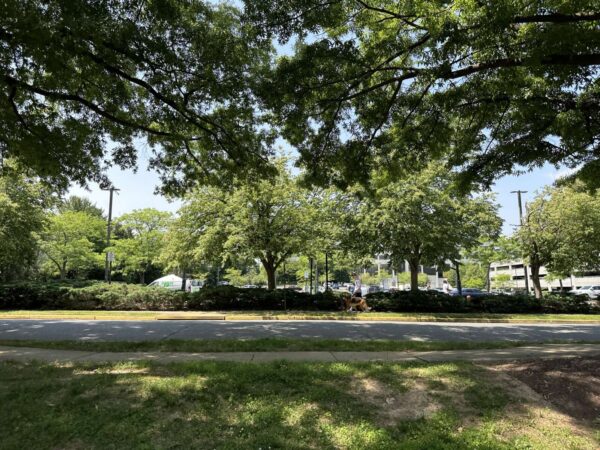
Fairfax County’s parking lots and streetscapes could look a little greener.
At a land use policy committee meeting on May 16, planning staff proposed a new update to the county’s landscaping and screening ordinance — the first major change in 40 years — that would make developers add more green landscaping to more parking lots and street frontages.
For parking lots, the current ordinance requires trees to be installed at any surface parking lot with 20 spaces or more. The new ordinance could expand that requirement to any lot with 10 parking spaces and increase the amount of tree coverage from 5% to 10%.
New parking garages, meanwhile, would be required to have 10% of their top decks covered with shade, although utilizing solar canopies could lead to a reduction in that percentage.
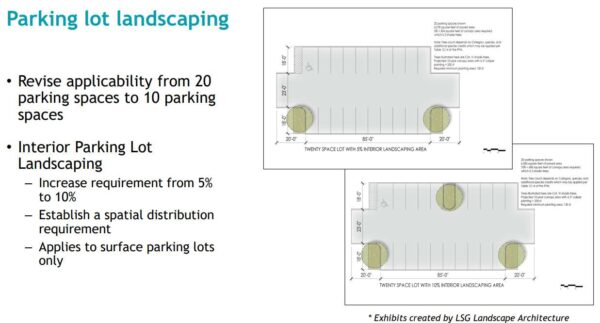
The ordinance also introduces “street frontage landscaping” — requiring developers to provide trees on private property provided they’re along private or public streets, not internal drive aisles. Single-family dwellings would be exempted.
One small but meaningful change would also adjust the types of trees seen in these green spaces, as it turns out Fairfax County’s previous specifications weren’t evergreen.
“When it comes to transitional screening a lot of waivers are applied for to use existing vegetation because they have to have 70% evergreens and that’s not common in Fairfax County,” Sara Morgan, a planner with the Department of Planning and Zoning, said. “This allows us to review [developments] on a case by case basis as we want to further encourage the use of existing vegetation, allowing you to have a mix that is different than [the ordinance] today if you retain existing vegetation.”
Similar to the zMOD update approved in 2021 — then reversed and reinstated earlier this year — county leadership said the landscaping and screening ordinance update is a good step forward on fixing some outdated code.
“It’s been 40 years since we updated these,” Board of Supervisors Chairman Jeff McKay said. “I think this is overall very, very good.”
The board approved new tree canopy standards earlier this year with the hope of encouraging private developers to plant more street trees in the public right-of-way.
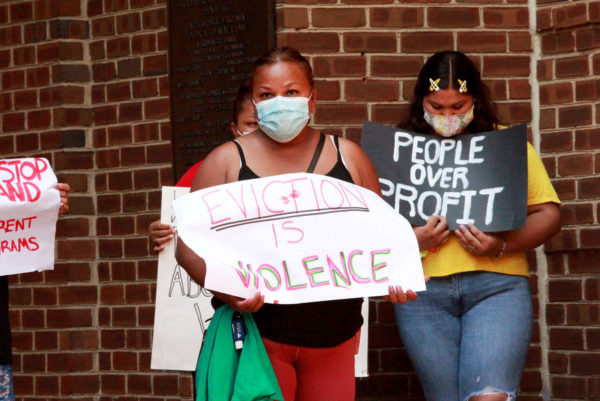
For years, Fairfax County leaders have been using carrots to encourage property owners to adhere to the county’s Human Rights Ordinance. Now, some of them want to start using the stick.
During a meeting on Tuesday (May 16) discussing the Metropolitan Washington Regional Fair Housing Plan, staff laid out how Fairfax County fits into a regional push for more affordable housing and better protections for residents.
In addition to regional goals, the plan includes specific goals for each locality in the region. For Fairfax County, that includes enforcement of the Human Rights Ordinance passed back in 2010.
The 46-page ordinance has a detailed list of prohibited forms of housing discrimination, including employment or credit, as well as protection against retaliation for filing a discrimination complaint.
Hunter Mill District Supervisor Walter Alcorn said, given that it’s been 13 years since the Human Rights Ordinance was passed, it’s high time to take the gloves off and double down on enforcement.
“We’re doing the testing, we’re identifying where we need to do more work; I’m all for that, but frankly, at some point, we have to do real law enforcement,” Alcorn said. “We’re going to have to pivot. If we’re not making progress, it’s time to take a more aggressive law enforcement stance with this. If we don’t see progress moving forward, I think we’d want to see an option for a more aggressive law enforcement approach.”
Amanda Schlener said Fairfax County publishes testing reports every two years and the most recent, from fiscal year 2022, indicated the county filed 22 enforcement complaints against private companies. Of those, 11 were settled for monetary conciliation agreements.
Fairfax County isn’t alone in seeing housing discrimination. Alexandria officials recently shared that property owners have evicted residents for receiving public assistance.
Staff also said the county could do more to let local residents know about their rights.
“Sometimes people are not 100% sure of what their rights are,” said Deputy County Executive Ellicia Seard-McCormick. “The carrot is in teaching people what we’re trying to achieve.”
Overall, the plan includes seven regional goals and eight local goals. The local goals are:
- Increase home-ownership opportunities
- Increase housing choice for voucher holders
- Deliver more affordable housing
- Preserve multi-family and manufactured units
- Increase awareness of existing and upcoming affordable homeownership and rental opportunities in communities of color and other vulnerable communities.
- Increase community awareness of Fair Housing rights by developing and providing new Fair Housing training and outreach activities.
- Enforce the Fairfax County Human Rights Ordinance through testing-initiated complaints that identify areas of concern.
- Increase the accessibility of fair housing services for individuals with disabilities and for whom English is not their first language.
The plan also has proposed actions to achieve the goals, like co-locating housing with public facilities on county-owned sites and developing closer relationships with community organizations that can help reach out to non-English-speaking communities.
“This is not the be-all, end-all of our affordable housing policy…but this document is indeed very valuable,” Board of Supervisors Chairman Jeff McKay said. “We can have the best goals in the world, but if we don’t have strategies and implementation and monitoring, we’re stuck not knowing what progress we’re making.”
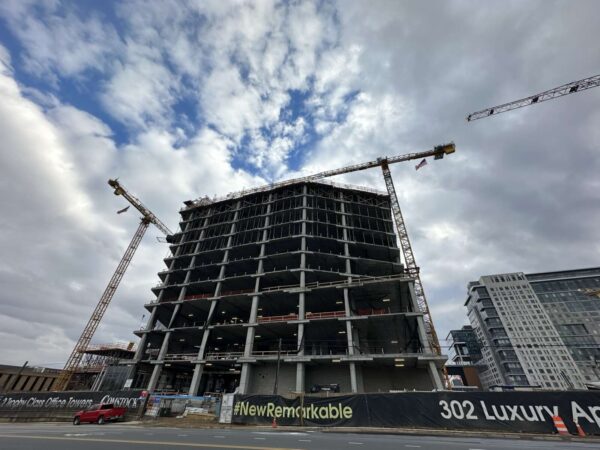
Fairfax County government staff said a proposal (action item 3) that aims to right-size how much developers pay for their transportation impacts could negatively affect funding for local projects.
Currently, developers have to pay to offset their transportation impact of added density if the development exceeds the limits established in the comprehensive plan for areas like Tysons, Reston or Centreville.
With the county trying to emphasize public transit in many of its denser areas, proposed changes could reduce the estimated “trip generation” of new development, and past contributions to programs offsetting that development impacts could be adjusted to the new standard.
Back in August, the Board of Supervisors directed staff to reevaluate guidelines for the county’s road funds in order to maintain the county as an appealing destination for developers, according to the board matter introduced by Chairman Jeff McKay.
“Recently, the County has been experiencing various forms of redevelopment, including repurposing buildings for different uses and the redevelopment of sites with new developments where other buildings had been rendered obsolete and torn down,” McKay wrote. “This redevelopment is vital in keeping the County economy competitive, as well as resilient…However, the adopted guidelines do not anticipate how to handle the new reality we are experiencing.”
McKay said some of the current contribution requirements for developers don’t reflect the reality of how much traffic the new developments are putting on roads:
For example, a project in Fair Lakes where an obsolete office building paid into the Road Fund in the 1980s is being replaced by townhomes. The townhomes will generate a lower trip rate than the office building. As such, and absent guidelines on how to address these instances, County staff was only able to give the developer credit for the previous contribution. However, that contribution was at a much lower square foot rate since it was made 40-years ago. Staff did not have the latitude to consider the lower trip generation rate, or how much the rates have increased over time when evaluating the Road Fund contribution.
But while that could benefit developers, staff also said that change could be a hit against the county’s transportation funding — and at-risk populations are most likely to be impacted.
According to the staff report:
Staff conducted an Equity Impact Assessment and concluded that this action may negatively impact at-risk populations. While there is a realized benefit of allowing developers to reduce their development derived contribution toward County road funds, that benefit comes at the expense of reduced transportation funding. Although the at-risk populations in most road fund areas are primarily within the low to average vulnerability index, the Centreville area has populations that falls within the high to very high vulnerability index. Reduced funding in all areas, especially Centreville, may result in reduced transportation services for populations in need of additional accessibility and transportation options.
In short, if approved, staff said there will be less money to spend on transportation projects.
“The proposed revisions to the road funds may result in reduced developer funds received for transportation projects,” the report said.
The item was docketed for review at a Board of Supervisors meeting on May 9 but was deferred.

Fairfax County is continuing to see the number of locals experiencing homelessness over the last year increase — and a new report said inflation and housing costs are partially to blame.
This year’s point-in-time count — an annual count of individuals in shelters, transitional housing, and experiencing unsheltered homelessness — found 1,310 people experiencing homelessness in Fairfax County.
That’s a 10% increase (119 people) over the previous year, when a slight drop was reported. Around 30% of those were adults experiencing chronic homelessness.
The survey found that 87 households said they were fleeing domestic violence and 229 households reported a history of domestic violence, according to Fairfax County.
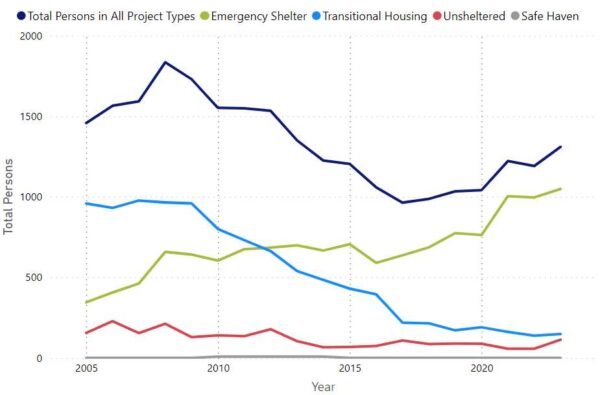
This year’s count follows a recent trend of homelessness increasing again after years of decline throughout the D.C. region.
“After a steady reduction of people experiencing homelessness on the night of the Point-in-Time Counts between the 2008 and 2017, a decrease of 47 percent (871 people),” the county said on the Point-in-Time report. “The number of people experiencing homelessness identified through the counts increased 27 percent (258 people) between 2017 and 2021 and then decreased 3 percent (31 people) in 2022.”
In particular, the report says there’s been a notable increase in families with children facing homelessness:
The number of people in families with children experiencing homelessness increased by 33 percent (188 people) between the 2022 and 2023 counts. This increase is primarily attributed to the multiple negative impacts of the COVID-19 pandemic on families in terms of health, employment, and inflationary costs, especially for housing. Meanwhile, the number of single adults experiencing homelessness decreased by 11 percent (71 people) during the same time.
As with the previous year, the report noted that people who identify as Black or African American are disproportionately likely to experience homelessness in Fairfax County:
The most significant disparity in the demographics of those experiencing homelessness on the night of the 2023 Point-in-Time Count remains the disproportionate representation of people identifying as Black or African American. While 10.8 percent of the general population in Fairfax County is estimated to identify as Black or African American , 48 percent of people experiencing homelessness on the night of the count identified as Black or African American. The imbalance slightly improved from the 2022 count, when 50 percent of people identified as Black or African.
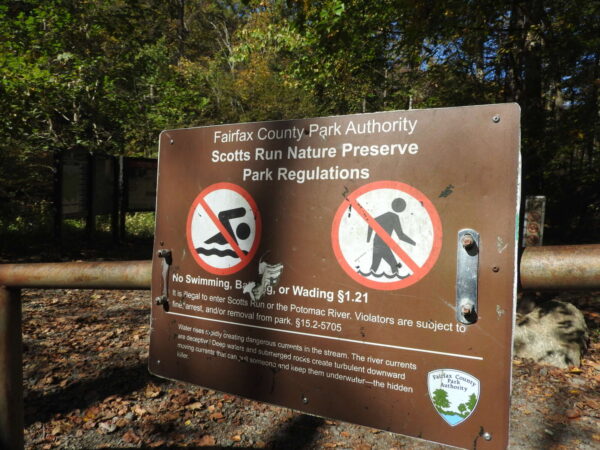
Fairfax County could be getting park rangers one day, but it won’t be this year.
With the police department’s staff stretched thin, the Fairfax County Park Authority (FCPA) has proposed a new solution for addressing service calls in its system: a park ranger program.
But while the Board of Supervisors directed staff on May 2 to review options for law enforcement in the park system, the $1.1 million request didn’t make the cut for the upcoming fiscal year 2024 budget, which will take effect July 1.
Depending on what the review recommends, funding could come in future years.
“In the proposed guidance for the FY 24-25 budget, the Board of Supervisors instructed county staff to ‘initiate a review of options to expand the presence of law enforcement within our park system, including the proposed park ranger program, and return to the Board with recommendations,'” Ben Boxer, public information officer for FCPA, said.
Boxer said issues like graffiti and thefts from vehicles have been increasingly problematic for the park authority in recent years.
“Parks, park users and staff often experience prohibited activities such as graffiti and destruction of property, unauthorized use, trespassing, encroachment, theft from vehicles, animal/dog bites, drug and alcohol use, littering, etc,” Boxer said. “These issues have always been a problem in parks but with Park Authority staffing cuts over the years, this type of activity has been steadily increasing and has driven the need to request and fund police coverage during the past several years.”
The FCPA has requested $1.1 million for a pilot program, consisting of six park rangers and three chief park rangers, along with vehicles and supplies. Those rangers would patrol the parks and educate the community on park rules and regulations.
Boxer said the possible Park Ranger pilot program is based on similar programs in Arlington County and Prince William County.
“Park safety and security rangers have been shown to help minimize the degradation of parks and improve the community’s park experience and satisfaction,” Boxer said. “The role is different from that of traditional law enforcement but can significantly alleviate the pressure on police in responding to calls.”
Instead, the new budget focuses on providing tax relief and increasing county employee pay. The budget is scheduled for adoption on today (Tuesday).

Fairfax County is pushing forward on a program that could have the county government split the bill for private stormwater projects with property owners.
Flooding doesn’t end at the property line and the Local Stormwater Management Assistance Fund aims to help boost stormwater management on private property. At an environmental committee meeting of the Board of Supervisors on April 25, staff presented an update on the program.
“This is a good example of how: even when we say everything is private, it’s your responsibility, at the end of the day, if things fall apart, they somehow end up in our lap,” said Hunter Mill District Supervisor Walter Alcorn.
The pilot divided the cost-sharing based on the percentage of property that’s public versus private. For a stormwater issue where most of the drainage is on public land, the county will pay most of the bill, whereas for an issue where the drainage is mostly on private property, the owners would pay the majority.
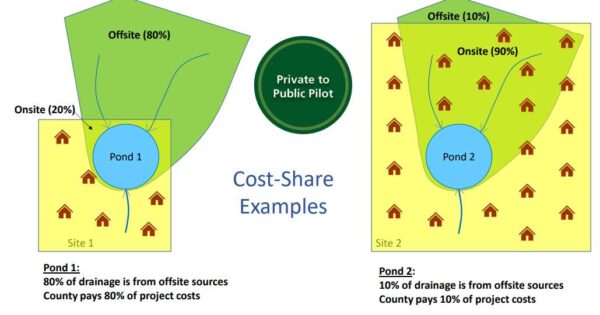
The initial budget for the program would be $250,000, with up to $7,000 allowed for each project applying to the fund. Staff said no more than 30 projects could be funded per year through the program, butwith the current eligibility restrictions, even 30 projects was somewhat optimistic.
The county is currently finishing up a pilot program that included the Millwood Pond, Virginia Center or Nutley, Green Trails and Gunston Corner facilities.
The county has signed an agreement with the Millwood Pond owners but determined no maintenance was needed. A “complex” maintenance project at Nutley has been completed, while one at Green Trails is under construction. Negotiations on an agreement for the Gunston Corner pond are still underway.
After the pilot finishes, staff will return to the Board of Supervisors’ environmental committee.

